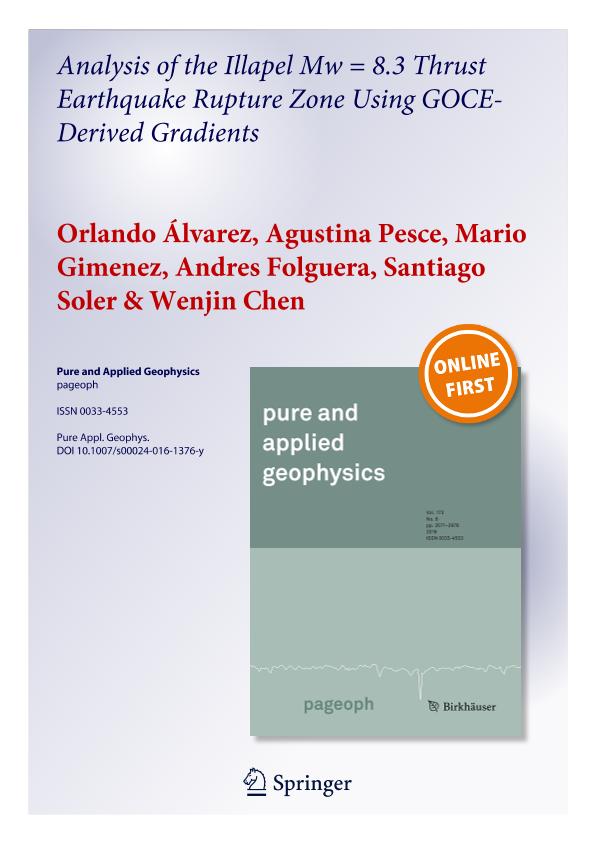Mostrar el registro sencillo del ítem
dc.contributor.author
Alvarez Pontoriero, Orlando

dc.contributor.author
Pesce, Agustina

dc.contributor.author
Gimenez, Mario Ernesto

dc.contributor.author
Folguera Telichevsky, Andres

dc.contributor.author
Soler, Santiago Rubén

dc.contributor.author
Chen, Wenjin
dc.date.available
2018-09-19T17:59:35Z
dc.date.issued
2017-01
dc.identifier.citation
Alvarez Pontoriero, Orlando; Pesce, Agustina; Gimenez, Mario Ernesto; Folguera Telichevsky, Andres; Soler, Santiago Rubén; et al.; Analysis of the Illapel Mw = 8.3 Thrust Earthquake Rupture Zone Using GOCE-Derived Gradients; Springer; Pure And Applied Geophysics; 174; 1; 1-2017; 47-75
dc.identifier.issn
0033-4553
dc.identifier.uri
http://hdl.handle.net/11336/60255
dc.description.abstract
Satellite gravimetry has proven to be a useful tool to identify mass anomalies along a subduction interface, interpreted as heterogeneities related to the rupture process during megathrust earthquakes. In the last years, different works, reinforced with data derived from satellite gravity missions as GRACE and now GOCE, have analyzed not only the static component of the Earth gravity field, but also its temporal variations and relation to the seismic cycle. In particular, during the last decade, the Chilean margin has been affected by three megathrust earthquakes (with Mw >8): Maule 2010 Mw = 8.8, Pisagua 2014 Mw = 8.2 and recently the Mw = 8.3 Illapel event. Then, the recently completed GOCE mission (November 2009 to November 2013) offered a unique opportunity to study the Maule February 2010 and Pisagua April 2014 events by means of gravity gradients, directly measured at satellite height altitudes, which allowed mapping density heterogeneities with greater detail than the gravity anomaly which has been used in most studies up to now. In the present work, we use the last GOCE model (GO_CONS_GCF_2_DIR_R5), the one of higher spatial resolution (N = 300, λ/2 ≈ 66 km) derived from satellite-only data. The methodology used is the same as that to study the previous events, with the addition that now we derived a relation between the associated depths of a causative mass with a determined degree of the spherical harmonic expansion. This allowed to “decompose” the gravimetric signal, by cutting off the degree/order of the harmonic expansion, as depth increases. From this analysis, we found that prominent oceanic features such as the Challenger fracture zone and the Juan Fernandez ridge played a key role in latitudinal seismic segmentation for the Illapel earthquake rupture zone, acting as barriers/attenuators to the seismic energy release. We compared the slip model from Tilmann et al. (Geophysical Research Letters 43: 574–583. doi:10.1002/2015GL066963, 2016) for the Illapel earthquake with vertical gravity gradient with and without sediment correction, and at different degree/order of the harmonic expansion. From this analysis, we inferred that prominent oceanic features over the subducting Nazca plate play a key role in seismic segmentation not only at heavily sedimented trenches, but also at sediment-starved segments.
dc.format
application/pdf
dc.language.iso
eng
dc.publisher
Springer

dc.rights
info:eu-repo/semantics/openAccess
dc.rights.uri
https://creativecommons.org/licenses/by-nc-sa/2.5/ar/
dc.subject
Goce
dc.subject
Megathrust Earthquakes
dc.subject
South Central Andes
dc.subject
Spherical Harmonics
dc.subject
Vertical Gravity Gradient
dc.subject.classification
Geoquímica y Geofísica

dc.subject.classification
Ciencias de la Tierra y relacionadas con el Medio Ambiente

dc.subject.classification
CIENCIAS NATURALES Y EXACTAS

dc.title
Analysis of the Illapel Mw = 8.3 Thrust Earthquake Rupture Zone Using GOCE-Derived Gradients
dc.type
info:eu-repo/semantics/article
dc.type
info:ar-repo/semantics/artículo
dc.type
info:eu-repo/semantics/publishedVersion
dc.date.updated
2018-09-18T13:18:54Z
dc.identifier.eissn
1420-9136
dc.journal.volume
174
dc.journal.number
1
dc.journal.pagination
47-75
dc.journal.pais
Suiza

dc.description.fil
Fil: Alvarez Pontoriero, Orlando. Universidad Nacional de San Juan. Facultad de Ciencias Exactas, Físicas y Naturales. Instituto Geofísico Sismológico Volponi; Argentina. Consejo Nacional de Investigaciones Científicas y Técnicas; Argentina
dc.description.fil
Fil: Pesce, Agustina. Universidad Nacional de San Juan. Facultad de Ciencias Exactas, Físicas y Naturales. Instituto Geofísico Sismológico Volponi; Argentina. Consejo Nacional de Investigaciones Científicas y Técnicas; Argentina
dc.description.fil
Fil: Gimenez, Mario Ernesto. Universidad Nacional de San Juan. Facultad de Ciencias Exactas, Físicas y Naturales. Instituto Geofísico Sismológico Volponi; Argentina. Consejo Nacional de Investigaciones Científicas y Técnicas; Argentina
dc.description.fil
Fil: Folguera Telichevsky, Andres. Consejo Nacional de Investigaciones Científicas y Técnicas. Oficina de Coordinación Administrativa Ciudad Universitaria. Instituto de Estudios Andinos "Don Pablo Groeber". Universidad de Buenos Aires. Facultad de Ciencias Exactas y Naturales. Instituto de Estudios Andinos "Don Pablo Groeber"; Argentina
dc.description.fil
Fil: Soler, Santiago Rubén. Universidad Nacional de Rosario. Facultad de Ciencias Exactas, Ingeniería y Agrimensura; Argentina. Consejo Nacional de Investigaciones Científicas y Técnicas; Argentina
dc.description.fil
Fil: Chen, Wenjin. Università degli Studi di Trieste; Italia. Wuhan University. School of Geodesy and Geomatics. Institute of Geodesy and Geophysics; China
dc.journal.title
Pure And Applied Geophysics

dc.relation.alternativeid
info:eu-repo/semantics/altIdentifier/doi/http://dx.doi.org/10.1007/s00024-016-1376-y
dc.relation.alternativeid
info:eu-repo/semantics/altIdentifier/url/https://link.springer.com/article/10.1007%2Fs00024-016-1376-y
Archivos asociados
